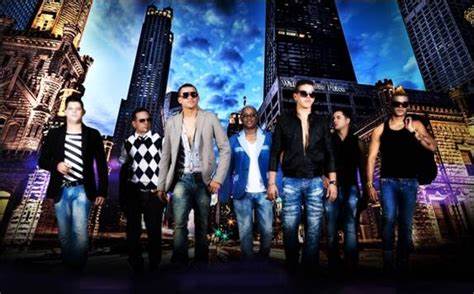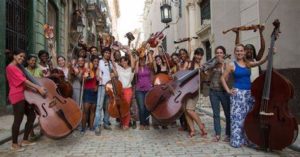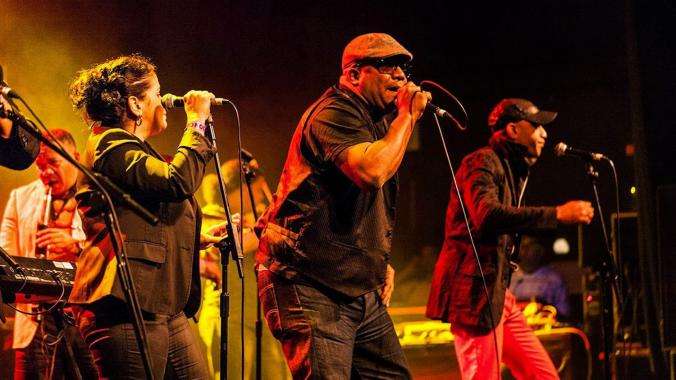LA MUSICA CUBANA EN ESTADOS UNIDOS DE LOS AÑOS SESENTA Y SETENTA. PHOTOS. VIDEOS
El triunfo de la Revolución de 1959 en Cuba determinó que muchos músicos cubanos emigraran hacia diversos países, asentándose en localizaciones tales como Florida y Nueva York, en los Estados Unidos, así como en Puerto Rico. En Cuba, los artistas y su obra quedaron bajo el control del Estado Socialista y su empresa oficial de grabaciones y ediciones musicales EGREM. El gobierno de Castro abolió las leyes que amparaban los derechos de autor, clausuró muchos de los locales donde la música popular acostumbraba ser escuchada (como los Clubes Nocturnos o Night Clubs), así que indirectamente dejó a muchos artistas fuera de sus fuentes de trabajo. Esto produjo sin dudas un efecto nocivo en la evolución de la danza y la música popular.
Aún así, la música cubana moderna siempre se ha caracterizado por una constante búsqueda de nuevas sonoridades mediante la fusión de diversas influencias y estilos.
CAMBIO MUSICAL EN LA NUEVA GENERACION CUBANA..
Muchos artistas jóvenes comenzaron a estudiar entonces música clásica en vez de popular, y los músicos empleados por el gobierno recibieron obligatoriamente clases en planteles oficiales. En Cuba, el movimiento de la Nueva Trova, que incluía a Pablo Milanés, reflejó los nuevos ideales de izquierda. El estado tomó el control del lucrativo Cabaret Tropicana, el cual continuó siendo una popular atracción para los turistas extranjeros hasta 1968, cuando fue clausurado junto con muchos otros locales, y después reabierto con el renacimiento del turismo.200p202 El turismo fue casi inexistente durante tres décadas, y la música tradicional podía ser encontrada en las Casas de La Trova locales. Los músicos que tenían un trabajo oficial, eran contratados a tiempo completo y recibían un salario del estado, después de egresar de algún conservatorio.
El colapso de la URSS en 1991, y la pérdida de su apoyo financiero, cambiaron la situación radicalmente. El turismo fue considerado una fuente respetable de ingresos de nuevo, y así mismo la música popular como parte de la industria turística. Los músicos fueron autorizados entonces a viajar al extranjero, e inclusive vivir fuera del sistema controlado por el estado.
Una lista de famosos artistas del Exilio cubano incluye a: Celia Cruz y todo el conjunto que actuaba con la Sonora Matancera, Carlos “Patato” Valdes, Israel Cachao López, La Lupe, Arturo Sandoval, Willy Chirino, Hansel y Raúl, La Palabra, Paquito D’Rivera, Bebo Valdés y Gloria Estefan, entre tantos otros. Muchos de esos músicos, incluyendo a Celia Cruz, se alinearon estrechamente con una ideología opuesta a la Revolución cubana, y fueron considerados en Cuba como “no-personas”, un término acuñado por George Orwell en su famosa novela 1984 (novela), que constituye una metáfora de los regímenes totalitarios.
VIDEOS- Ruben Blades interpreta… (Salsa)…
Los artistas disidentes fueron omitidos de los libros de texto oficiales, y la difusión y publicación de sus creaciones fue prohibida. Al menos, Celia Cruz fue reconocida en una obra cubana de referencia, el Diccionario Enciclopédico de la Música Cubana de Radamés Giro.
CREACION MUSICAL DE LA SALSA
Despues de llegar a Estados Unidos los ritmos cubanos el Mambo, el Cha Cha Cha y el “Filin”, fue “la Salsa” la cuarta innovación basada en la música cubana que impactó a los Estados Unidos, y difiere de las demás en que inicialmente fue desarrollada en los Estados Unidos y no en Cuba. Debido a que Cuba posee tantos géneros originales, su promoción fuera del país siempre ha constituido un problema, debido a la dificultad que confronta un extranjero para distinguir las diferencias entre diversos ritmos que para los cubanos son evidentes. De esa manera, en dos ocasiones durante el siglo xx, dos términos fueron utilizados con el propósito de resolver ese problema. El primero fue en los años treinta, después de que El Manisero se convirtiera en un éxito internacional. Este fue llamado Rumba, aunque tiene poca relación con la llamada Rumba urbana, de cajón o de solar,221 y es en realidad un Son cubano o “son-pregón”. Durante mucho tiempo, la palabra Rumba fue utilizada como denominación para cualquier forma de música popular cubana.
La segunda ocasión ocurrió durante el período de 1965 a 1975 en Nueva York, cuando algunos músicos de origen cubano y puertorriqueño se unieron para crear el más popular estilo latino del período posterior al Chachachá. Esta música fue llamada Salsa. Nadie sabe cómo ocurrió, pero todo el mundo reconoce el beneficio que conllevó utilizar un término común para denominar el Son, el Mambo, la Guaracha, la Guajira (música), el Guaguancó y otros géneros de la música cubana.
La afirmación de que la Salsa no es más que música cubana, ha sido discutida durante más de treinta años, e inicialmente no se podía percibir en realidad una gran diferencia entre una y otra. Cubanos y no-cubanos, como Tito Puente, Rubén Blades y otros muchos expertos en música cubana y Salsa, siempre han dicho que la Salsa es solo otro nombre para denominar la música cubana. Tito Puente expresó una vez: “Ahora la llaman Salsa, después la podrán llamar sofrito, pero para mí siempre será música cubana”. También Willie Colón dijo: “Si miras a una orquesta de los años cuarenta tocando música cubana, verás exactamente los mismos instrumentos que en la Salsa. Benny Moré, el mayor sonero de todos los tiempos, estaba cantando boleros con una cadencia salsera desde los años cuarenta.
Pero con el tiempo, las agrupaciones de Salsa han trabajado con otras influencias. Por ejemplo, al final de los años sesenta Willie Colón produjo algunos números donde utilizaba ritmos brasileños. Algunos programas radiales en Nueva York, ofrecieron ‘Salsarengue” como otra opción, y más tarde se le llamó “Salsa romántica” a un tipo de bolero edulcorado.
No fue hasta los años cincuenta que la música cubana penetró en las orquestas puertorriqueñas, las cuales antes de eso tocaban Plena, Bomba, y otros géneros populares de la Isla. Muchos músicos famosos puertorriqueños fueron a Cuba entre los años treinta y cuarenta con el propósito de aprender los estilos musicales cubanos, pero no fue hasta la llegada de Fidel Castro al poder en 1959, cuando se paralizó la exportación de música cubana al mundo, que los puertorriqueños en Nueva York pudieron tener éxito y ser tomados en cuenta.
Según algunos estudiosos del tema, lo que se conoce como Salsa hoy día, fue llevado a Nueva York por Dizzy Gillespie y Chano Pozo en los años cuarenta. Sin embargo, otros son de la opinión de que no solo la Salsa de Nueva York era diferente a los géneros vigentes en Cuba, sino que los estilos de la Salsa en Venezuela, Colombia y otros países también pudieran ser identificados individualmente.
CUBAN MUSIC IN THE UNITED STATES OF THE SIXTY AND SEVENTY YEARS. VIDEOS
The triumph of the 1959 Revolution in Cuba determined that many Cuban musicians emigrated to various countries, settling in locations such as Florida and New York, in the United States, as well as in Puerto Rico. In Cuba, the artists and their work remained under the control of the Socialist State and its official music recording and publishing company EGREM. The Castro government abolished the laws that protected copyright and closed many of the places where popular music used to be heard (such as Night Clubs or Night Clubs), thus indirectly leaving many artists out of their jobs. This undoubtedly had a deleterious effect on the evolution of popular dance and music.
Even so, modern Cuban music has always been characterized by a constant search for new sounds through the fusion of various influences and styles.
MUSICAL CHANGE IN THE NEW CUBAN GENERATION…
Many young artists then began to study classical rather than popular music, and government-employed musicians were required to take classes at official schools. In Cuba, the Nueva Trova movement, which included Pablo Milanés, reflected the new ideals of the left. The state took control of the lucrative Tropicana Cabaret, which continued to be a popular attraction for foreign tourists until 1968, when it was closed along with many other venues, then reopened with the revival of tourism.200 p202 Tourism was almost non-existent for three decades, and traditional music could be found in the local Casas de La Trova. The musicians who had an official job were hired full-time and received a salary from the state, after graduating from a conservatory.
The collapse of the USSR in 1991, and the loss of its financial support, changed the situation radically. Tourism was considered a respectable source of income again, as was popular music as part of the tourist industry. Musicians were then allowed to travel abroad and even live outside the state-controlled system.
A list of famous Cuban exile artists includes: Celia Cruz and the entire ensemble that performed with Sonora Matancera, Carlos “Patato” Valdes, Israel Cachao López, La Lupe, Arturo Sandoval, Willy Chirino, Hansel and Raúl, La Word, Paquito D’Rivera, Bebo Valdés and Gloria Estefan, among many others. Many of those musicians, including Celia Cruz, closely aligned with an ideology opposed to the Cuban Revolution and were considered in Cuba as “non-persons,” a term coined by George Orwell in his famous novel 1984 (novela), which It is a metaphor for totalitarian regimes.
Dissident artists were omitted from official textbooks, and the dissemination and publication of their creations were prohibited. At least, Celia Cruz was recognized in a Cuban reference work, the Encyclopedic Dictionary of Cuban Music by Radamés Giro.
MUSICAL CREATION OF SALSA
After the Cuban rhythms of Mambo, Cha Cha Cha, and “Filin” arrived in the United States, Salsa is the fourth innovation based on Cuban music that impacted the United States and differs from the others in that it was initially developed in the United States and not in Cuba. Because Cuba has so many original genres, their promotion outside the country has always been a problem, due to the difficulty that a foreigner faces in distinguishing the differences between various rhythms that are obvious to Cubans. Thus, on two occasions during the 20th century, two terms were used for the purpose of solving this problem. The first was in the thirties after El Manisero became an international success. This was called Rumba, although it has little relation to the so-called urban, Cajon, or solar Rumba,221 and is actually a Cuban Son or “son-pregón”. For a long time, the word Rumba was used as a denomination for any form of Cuban popular music.
The second occasion occurred during the period from 1965 to 1975 in New York when some musicians of Cuban and Puerto Rican origin came together to create the most popular Latin style of the post-Chachachá period. This music was called Salsa. No one knows how it happened, but everyone recognizes the benefit of using a common term to describe the Son, the Mambo, the Guaracha, the Guajira (music), the Guaguancó, and other genres of Cuban music.
The affirmation that Salsa is nothing more than Cuban music has been discussed for more than thirty years, and initially one could not really perceive a great difference between one and the other. Cubans and non-Cubans, like Tito Puente, Rubén Blades, and many other experts on Cuban music and Salsa, have always said that Salsa is just another name for Cuban music. Tito Puente once said: “Now they call it Salsa, later they may call it sofrito, but for me, it will always be Cuban music.” Willie Colón also said: “If you look at an orchestra from the 1940s playing Cuban music, you will see exactly the same instruments as in Salsa. Benny Moré, the greatest sonero of all time, had been singing boleros with a salsa cadence since the 1940s.
But over time, Salsa groups have worked with other influences. For example, at the end of the sixties, Willie Colón produced some numbers where he used Brazilian rhythms. Some radio programs in New York offered ‘Salsarengue’ as another option, and later a type of sweetened bolero was called ‘Salsa Romantica.
It was not until the 1950s that Cuban music penetrated Puerto Rican orchestras, which before then played Plena, Bomba, and other popular genres from the Island. Many famous Puerto Rican musicians went to Cuba between the 1930s and 1940s with the purpose of learning Cuban musical styles, but it was not until the arrival of Fidel Castro to power in 1959, that the export of Cuban music to the world was paralyzed, that Puerto Ricans in New York were able to succeed and be taken into account.
According to some scholars of the subject, what is known as Salsa today was brought to New York by Dizzy Gillespie and Chano Pozo in the 1940s. However, others are of the opinion that not only New York Salsa was different from the current genres in Cuba, but the styles of Salsa in Venezuela, Colombia, and other countries could also be identified individually.
Agencies/ Wiki/ CubanMusicHist./ Extractos/ Excerpts/ Internet Photos/ YouTube/ Arnoldo Varona/ www.TheCubanHistory.com
THE CUBAN HISTORY, HOLLYWOOD.



 LA MÚSICA Cubana en Estados Unidos de los Años Sesenta y Setenta. VIDEOS. * CUBAN MUSIC in the United States of the Sixty and Seventy Years. PHOTOS. VIDEOS.
LA MÚSICA Cubana en Estados Unidos de los Años Sesenta y Setenta. VIDEOS. * CUBAN MUSIC in the United States of the Sixty and Seventy Years. PHOTOS. VIDEOS.







